Chinese Crested Dog
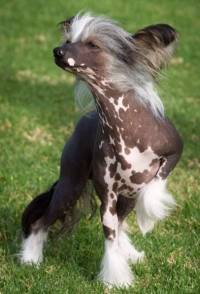 Chinese Crested Dog
Chinese Crested Dog
Labelled 'Chinese' because the Chinese Crested Dog was first identified during a Chinese Dynasty which existed more than two thousand years ago. This Toy breed is best known as a smooth hairless dog except for hair on its head, crest of neck, feet and tail. But the Chinese Crested also comes in a 'Powder Puff' double-coated variety which has an undercoat plus a soft veil of hair which forms the topcoat. Today, the two varieties compete together in the same breed classes all over the world.
History of the Chinese Crested Dog
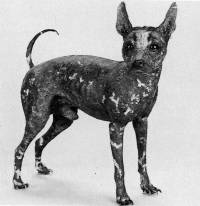 'Queen of Sheba'
'Queen of Sheba'
Like other hairless breeds, the Chinese Crested is unknown in the wild. Labelled 'Chinese' because it was first described in Chinese history during the Han Dynasty (221-206 BC)[1], Chinese Crested were first brought to the UK in the late 1800's, probably by traders. Regarded as a curiosity, this 25 cm high hairless dog pictured is the same size as a Chinese Crested. But it was called an 'African Hairless' named 'the Queen of Sheba'. Preserved by taxidermy, it was presented to the British Museum of Natural History at Tring, UK in 1903.
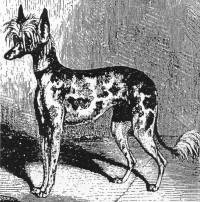 Chinese Crested Dog 1866
Chinese Crested Dog 1866
It is is not known whether the Chinese Crested's particular hairless gene is related to those known in dogs in other parts of the world. This unique gene expresses itself with one tuft of long hair on the top of the head extending over the crest of the neck, and other long tufts on the feet and tail. Maybe the Chinese Crested's unique tufts of long hair are the result of selective breeding.
The Chinese Crested Becomes a Pure Breed
 Chinese Crested Dog 1896
Chinese Crested Dog 1896
Chinese Crested were first listed in Britain 1894 like the illustration of the semi-erect eared specimen on the left were listed in the 'Foreign Breeds' section of the Kennel Gazette despite those without pricked ears not being permitted to be exhibited. Whilst registrations in the UK were spasmodic, this was not the case in America. Prior to 1959, when the American Hairless Dog Club was formed, all hairless dogs were registered with the American Kennel Club. But when this service was discontinued, Mrs Debra Wood of Crest Haven Kennels, single-handedly collated all the American registrations. This was to became the saviour of the Chinese Crested Dog on both sides of the Atlantic. So although in the first instance UK sent dogs to USA to establish the breed, USA later exported sufficient numbers of Chinese Crested's back UK to re-vitalise it there. By 1969 this created sufficient interest to inspire the UK enthusiasts to establish their own Chinese Crested Club[1].
But difficulty then arose because many enthusiasts were not comfortable about accepting 'Powder Puff' variety within the same breed as the hairless.
The 'Powder Puff' Variety
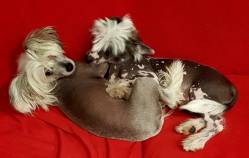 'Hairy hairless' and hairless
'Hairy hairless' and hairless
Chinese Crested, like most hairless breeds come in two varieties - hairless and fully coated. Hairlessness in dogs is the result of an incomplete dominant gene. This means that if the puppy receives the dominant gene for hairlessness from both parents, it will die. That is why the fully coated or 'Powder Puff' variety is genetically essential for the survival of the hairless puppies.
 Chinese Crested newly born litter
Chinese Crested newly born litter
Here we have a picture of a newly born litter with 3 hairless pups obvious beside their 'Powder Puff' litter mate. Puppies born with a fine layer of hair like the third pup from the left, can develop an unpredictable amount of hair, from almost no hair on the crest (head), feet or tail to sparse body hairs anywhere, even in isolated small patches. Popularly called 'hairy hairless', if expertly removed leaving just the crest, feet and tail, it can be difficult to determine whether or not any particular dog is a true hairless or whether it is a sparsely coated 'hairy hairless' with the excess body hair shaved off!
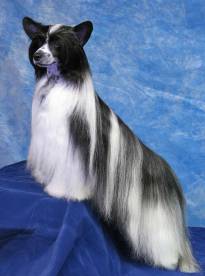 Chinese Crested "Powder Puff'
Chinese Crested "Powder Puff'
Additionally the coat of the 'Powder Puff' variety can vary. As the dog matures, it should have an undercoat with coarser guard hairs which will mingle with the undercoat and form the 'veil' required by the Breed Standard. The Chinese Crested is unique among hairless breeds because it carries a gene for long coat. But the length of coat should never be excessive, obscuring the natural outline of the dog.[2c].
So when the breed was first being officially recognized, questions had to be resolved as to whether or not 'Powder Puffs' should be registered as a separate breed, or as a variety of the same breed. This argument was the reason why the Chinese Crested Dog was not recognized until 1988 in UK and 1991 in USA[2a].
History of Chinese Crested Dogs in Australia
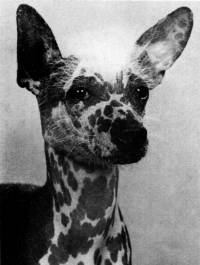 'Miniatura La Streaker'
'Miniatura La Streaker'
Meanwhile, in 1973 two hairless Chinese Crested Dogs, Staround Zorro and Staround Yinga were imported from UK by Mrs Win Jackson of Perth, Western Australia. From their first litter, in 1974 'Miniatura La Streaker' was born and successfully campaigned by Miss M Olive to the title of Australian Champion. The ANKC had accepted the Breed Standard put in place by the British Chinese Crested Club at that time which did not include the 'Powder Puff' variety. So while UK and USA were still finalising how to include the 'Powder Puff' variety within their breed standards,this Australian bred Chinese Crested Dog became the first Show Champion anywhere in the world! After many more imports from both UK and USA, Chinese Crested Clubs were formed by zealous and dedicated breeders in all Australia's Eastern States. By 1988, when UK recognised the Powder puffs as a variety of Chinese Cresteds, Australia followed.
The Chinese Crested Dog Today
 Chinese Crested 'Deer' Type
Chinese Crested 'Deer' Type
As discussed above, this small, active and graceful dog comes in two varieties, Hairless and 'Powder Puff'. He can have either a smooth hairless body, with hair on its head, the crest of its neck, feet and tail, or he can covered by an undercoat combined with a top-coat consisting of soft veil of hair. He comes in any colour or combination of colours.
 Chinese Crested 'Cobby' Type
Chinese Crested 'Cobby' Type
Within both the Hairless and the 'Powder Puff' varieties there are two distinct types - a deer type which is racy and fine boned, and cobby type which is heavier in body and bone, has a wider stature combined with a shorter body and topline which can make it look shorter in leg. The back skull is also wider and the eyes can look somewhat rounder. These two types mean there can also be a wide variation in size with the height ranging from 23 - 33 cms (9 - 13 inches) and weight up to 5.4 Kilos (12 lbs). But he usually is seen somewhere between these two limits.
Head and Ears
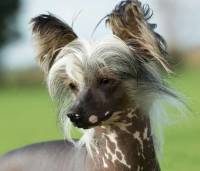 Chinese Crested Dog
Chinese Crested Dog
The slightly rounded, elongated skull with its clean cheeks and smooth outline, tapers to the muzzle. The slight stop is equidistant between the skull and the tapering muzzle which has tight, thin lips without flews. Although the nose is prominent, any colour is acceptable. The ideal crest is preferably long and flowing, beginning at the stop and tapering off down neck. But sparse crests are also acceptable, often indicating a true hairless.
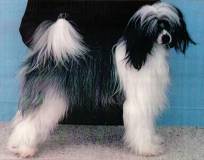 Chinese Crested 'Powder Puff' with dropped ears
Chinese Crested 'Powder Puff' with dropped ears
The medium sized almond shaped eyes should be as dark as possible and set wide apart. The large, erect ears are set low, with the highest point of the base of the ear level with outside corner of the eye. Sometimes fringing is present. In 'Powder Puffs' dropped ears are permissible.
Mouth
The Breed Standard calls for strong jaws with a normal scissors bite in both the Hairless and 'Powder Puff' varieties. But the hairless gene can affect the dentition, causing either missing teeth or deformities in the shape of the teeth themselves, particularly the canines as illustrated. Although breeders should aim for full dentition and normally shaped teeth in the Hairless variety, judges should be aware that missing or abnormally shaped teeth are typical in any hairless breed and therefore should not be severely penalized[2d].
 Chinese Crested Teeth normal
Chinese Crested Teeth normal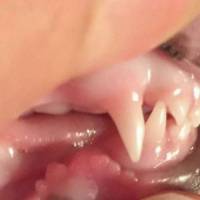 Chinese Crested Teeth hairless
Chinese Crested Teeth hairless
Body
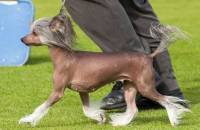 Chinese Crested Dog
Chinese Crested Dog
The neck should be free from throatiness, and sufficiently long to allow the head to be carried high when the dog is moving. The clean shoulders should be well laid back, the elbows carried close to the body under which there are long, slender forelegs. The pasterns fine, strong, and almost vertical finishing in long, narrow hare feet.
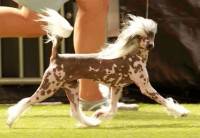 Chinese Crested Dog
Chinese Crested Dog
The supple body is of medium length to long with a deep and rather broad chest and ribs. The breast-bone should not be prominent but the brisket extends the elbows and when viewed in profile, there is a moderate tuck-up. The topline should be level and the muscular and well rounded. The hind legs should be set well apart, the stifles long and sweeping smoothly into the well let-down hock. The tail should be set high and carried up or out when in motion with a long and flowing plume, confined to lower two-thirds of tail. His elegant movement has long, flowing strides with good reach and drive.
References and Further Reading
[1] Juliette Cunliffe 'The Chinese Crested' Published by 'The Kennel Club' in 2001 through Interpet Publishing, England ISBN 1-903089-94-7 History of the Chinese Crested Page 9.
[2] Brenda Jones, 'The Complete Chinese Crested' Published by Ringpress Books 1990, Hertz UK ISBN 0 948955 46 5 Chapter 3 'The Chinese Crested' Pages 27.
[2a] Ibid., Chapter 3, 'The Chinese Crested' Page 29
[2c] Ibid., Chapter 6, 'The British Breed Standard' Page 58
[2d] Ibid., Chapter 5, 'Dentition' Page 46
[3] Kim Dennis-Bryan and Juliet Clutton-Brock - "Dogs of the Last Hundred Years at the British Museum" Published by British Museum (Natural History), London (1988) ISBN 0-565-01053-0 'African Hairless Dog' Page 102